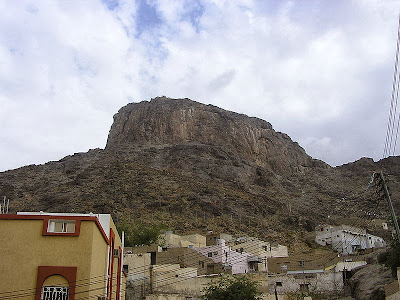Jabal al-Nour (also Jabal an-Nur or Jabal Nur),which can be
translated from Arabic(جبل النور),"The Mountain
of Light", or "Hill of Illumination",is a mountain near Mecca in Saudi Arabia 's
Hejaz region. It is one of the most popular
tourist attractions in Mecca , and no pilgrimage
to the 'Holy City
Naming
Since this is where the Prophet received the first verses of
the Quran(the Muslim holy book), the mountain was giving the title "Jabal-al-Nour".
"Jabal" in Arabic means mountain and "Nour" or "Noor"
means hidayat (guidance).This experience is sometimes identified with the
beginning of revelation; hence the present name. As for the exact date of the
first revelation it can be seen through investigation to fix the time to Monday
the 21st of Ramadan at night, i.e. August, 10, 610 C.E. or exactly 40 lunar years,
6 months and 12 days of age i.e., 39 Gregorian years, 3 months and 22 days.
Why this
mountain?
Before the Prophet Muhammad’s first revelation he would have
pleasant dreams. Among these dreams showed signs of his Prophethood starting to
appear as well as signs that the stones in Makkah would great him with Salam
which in turn proved true. These dreams lasted for six months. Also an
increasing need for solitude, lead him to seek seclusion and meditation in the
rocky hills which surrounded Mecca
Tahannuth
Tahannuth or tahannatha, verb, are words found in some of
the accounts of Muhammad’s first prophetic experience Tahannuth is immediately
glossed as tabarrur (“abstaining from sin”?): wa ’l-taḥannut̲h̲ al-tabarrur. Tahannuth
can be associated with an ancient custom of Kuraysh and that essentially it
consisted of veneration of the Ka’ba and works of charity while being withdrawn
on Jabal Al-Nour. It is suggested that tahannuth refers to the condition which,
in fikh, one assumes by making a binding vow- one becomes “liable” (hanith) to
fulfuil the vow. In the traditions about the prophet, the word would reflect
the idea that he made a vow to enter a period of retreat (iʿtikāf [q.v.]), a
practice of early Muslim times which was beginning less widespread as a result
of juristic disapproval of asceticism. It was because the practice was in
declind that the word was such a puzzle for later generations.
How Jabal-al
Nour looks today
One physical feature that differentiates it from other
mountains and hills is its strange looking summit, which makes it look more
like two mountains on top of each other. The top of the Mountain of Nour
The Mystery
of Cave Hira
A study, reported in August 2001 issued by the National
Geology, revealed that while investigating an ancient Greek temple that was
based on the Oracles of Delphi suggested the possibility that the vicinity of
the shrine that caused the oracles of Delphi to
experience their powers was attributed to intoxicating fumes. Not to say that
the Prophet Muhammad’s religious experience was not based on his faith but this
tries to gives a scientific explanation to a very powerful experience. However,
according to Welch these revelations were accompanied by mysterious seizures, and
reports are unlikely to have been forged by later Muslims.
When Muhammad returned to the cave seeking the angel Gabriel
after speaking to him once before he waited and prayed, was of no avail. In
despair, haunted by terrible doubts and assailed by fears of madness, Muhammad
climbed onto a precipice and prepared to leap to his death. At that very moment,
the angel appeared before him again and raised his hands, repeated, “I am
Gabriel, and thou art Muhammad, the Messenger of Allah.” Muhammad froze on the
edge of the chasm in a spellbound trance. Hours passed. That night, one of
Khadija’s servants came and found Muhammad still perched on a crag, lost in
ecstasy, and led him home.
The
Pilgrimage to Jabal al-Nour
Pilgrims on Jabal al-Nour Hundreds of thousands of Muslims
arrive in Saudi Arabia Mount Noor in the holy city of Mecca Mountain of Mercy Mount
Arafat


Niciun comentariu:
Trimiteți un comentariu